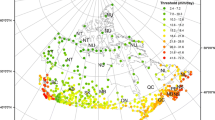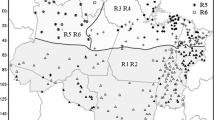Abstract
The daily discharge time series in the lower Danube basin (Orsova) have been considered for the 1900–2005 period. The extreme value theory (EVT) is applied for the study of daily discharges incorporating some covariates. Two methods are applied for fitting the data to an extreme value distribution: block maxima and peaks over thresholds (POT). Using the block maxima approach associated with the use of the generalised extreme value (GEV) distribution, monthly and seasonal maxima of daily discharge for 1900–2005 have been analysed. Separately the monthly maxima of daily discharge for the 1958–2001 was analysed in order to be compatible with atmospheric circulation available from ERA-40. For performing parameter estimation, the maximum likelihood estimation (MLE) method was used. From the three possible types of GEV distribution, a Weibull distribution fits both the monthly and seasonal maxima of the daily discharges very well. The North Atlantic Oscillation (NAO) and the first ten principal components (PC) of the decomposition in multi-variate empirical orthogonal functions (MEOF) of three atmospheric fields (sea level pressure, 500 hPa and 500–1000 hPa thickness) over the Atlantic-European region (ERA-40), have been introduced as covariates. An improvement over the model without the covariate is found by incorporating NAO as the covariate in location parameter, especially for the spring maxima having the NAO as predictor during the winter. Related to atmospheric circulation influence, the most significant results are obtained by incorporating the first 10 PCs of the MEOF in the location parameter of GEV distribution within a month before the month of the discharge level. Regarding the POT approach associated with generalised Pareto distribution (GPD), different thresholds have been tested for daily discharges in the period 1900–2005, where the maxima were fitted by a bounded (or beta) distribution.











Similar content being viewed by others
References
Bellone E, Hughes JP, Guttorp P (2000) A hidden Markov model for downscaling synoptic atmospheric patterns to precipitation amounts. Clim Res 1:51–12
Beniston M, Diaz HF (2004) The 2003 heat wave as an example of summers in a greenhouse climate? Observations and climate model simulations for Basel, Switzerland. Glob Planet Change 44:73–81
Beniston M, Stephenson D (2004) Extreme climatic events and their evolution under changing climatic conditions. Glob Planet Change 44:1–9
Briffa KR, Osborn TJ, Schweingruber FH, Jones PD, Shiyatov SG, Vaganov EA (2002) Tree-ring width and density data around the Northern Hemisphere: part 1, local and regional climate signals. Holocene 12(6):737–757
Chandler RE (2005) On the use of generalized linear models for interpreting climate variability. Environmetrics 16(7):699–715
Chen D, Yuan X (2004) A Markov model for seasonal forecast of Antarctic sea ice. J Climate 17:3156–3168
Cubasch U, Zorita E, Gonzales-Rouco JF, v. Storch H, Fast I (2005) Simulating the last 1000 years with a 3D coupled model. RegClim Phase III, General Technical Report No. 8, Norwegian Meteorological Institute, 9–26
Ekstrom M, Fowler HJ, Kilsby CG, Jones PD (2005) New estimates of future changes in extreme rainfall across the UK using regional climate model integrations. 2. Future estimates and use in impact studies. J Hydrol 300:234–251
Gilleland E, Katz RW (2005) Tutorial for the Extremes Toolkit: weather and climate applications of extreme value statistics. Available online at http://www.asssessment.ucar.edu/. Cited 02 April 2008
Gilleland E, Nychka D (2005) Statistical models for monitoring and regulating ground-level ozone. Environmetrics 10:535–546
Goodess CM, Jones PD (2002) Links between circulation and changes in the characteristics of Iberian rainfall. Int J Climatol 22:1593–1615
Goodess CM, Palutikof JP (1998) Development of daily rainfall scenarios for the southeast Spain using a circulation type approach to downscaling. Int J Climatol 18:1051–1081
Haylock MR, Goodess CM (2004) Interannual variability of European extreme winter rainfall and link with mean large-scale circulation. Int J Climatol 24:750–776
Jaagus J (2006) Climatic changes in Estonia during the second half of the 20th century in relationship with changes in large-scale atmospheric circulation. Theor Appl Climatol 83:77–88
Jagger T, Elsner JB, Xufeng N (2001) A dynamic model of hurricane winds in coastal countries of the United States. J Appl Meteorol 40(5):853–863
Jones PD, Mann ME (2004) Climate over past millenia. Rev Geophys 42:RG2002. DOI 10.1029/2003RG000143
Katz RW, Parlange MB, Naveau P (2002) Statistics of extremes in hydrology. Adv Water Resour 25:1287–1304
Katz RW, Grace SB, Parlange MB (2005) Statistics of extremes: modeling ecological disturbances. Ecology 86(5):1124–1134
Kharin VV, Zwiers FW (2005) Estimating extremes in transient climate change simulations. J Climate 18:1156–1173
Luterbacher J, Dietrich D, Xoplaki E, Grosjean M, Wanner H (2004) European seasonal and annual temperature variability, trends and extremes since 1500. Science 303:1499–1503
Mann ME, Cane MA, Zebiak SE, Clement A (2005) Volcanic and solar forcing of the tropical Pacific over the past 1000 years. J Climate 18:447–456
Mareş C, Mareş I (2006) Variability and climate change, vol 1: Statistical modelling of climate extreme (in Romanian). University Books, Bucharest, Romania, 305 pp
Mareş C, Mareş I, Stanciu A (2005) Extreme climatic events in the precipitation time series in Romania and their impact in the Danube inferior basin. European Geosciences General Assembly 2005. Vienna, Austria, 24–29 April 2005
Schar C, Vidale PV, Lithl D, Frei C, Haberll C, Liniger M, Appenzeller C (2004) The role of increasing temperature variability in European summer heatwaves. Nature 427:332–336
Tebaldi C, Smith LR, Nychka D, Mearns L (2005) Quantifying uncertainty in projections of regional climate change: a Bayesian approach to the analysis of multimedia ensembles. J Climate 18:1524–1540
Wettstein J, Mearns L (2002) The influence of the North Atlantic-Arctic Oscillation on mean, variance and extremes of temperature in the northeastern United States and Canada. J Climate 15:3586–3600
Xue Y, Leetmaa A, Ji M (2000) ENSO prediction with Markov models: the impact of sea level. J Climate 13:849–871
Acknowledgements
We are grateful to E. Rudel and anonymous reviewers for their constructive comments. Authors also thank D. Stephenson from the University of Reading for providing a part of the software for the language R program. This study was supported by ENSEMBLES (GOCE-CT-2003-505539) EU project.
Author information
Authors and Affiliations
Corresponding author
Rights and permissions
About this article
Cite this article
Mares, C., Mares, I. & Stanciu, A. Extreme value analysis in the Danube lower basin discharge time series in the twentieth century. Theor Appl Climatol 95, 223–233 (2009). https://doi.org/10.1007/s00704-008-0001-0
Received:
Accepted:
Published:
Issue Date:
DOI: https://doi.org/10.1007/s00704-008-0001-0




